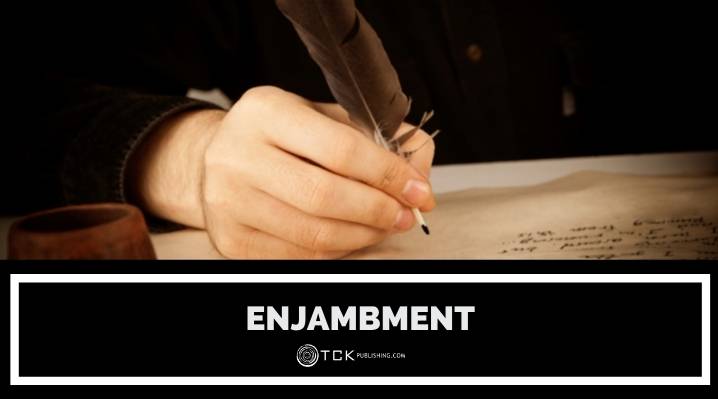
Enjambment is a literary device used in poetry where a line is continued on through the next line without any grammatical cues to indicate a stop, like this:
This train of thought will keep going
Despite the line already ending.
That’s a terrible couplet, but it should show you what an enjambment is. A poetic line is ended without a complete syntax and only becomes coherent when combined with the following line.
The lack of punctuation requires the reader to quickly read through the lines in order to reach the conclusion of the thought. This creates variations in the poem’s rhythm and flow, leading to a more dynamic read.
It’s also important to note that although poetry typically follows traditional grammar rules, it is ultimately up to you whether to capitalize the first word of a line or not, so the second part of an enjambed line can start with either a capitalized or uncapitalized word.
Examples of Enjambment
The best way to understand enjambments is to analyze a few examples. It’ll give you a more concrete image of what they are, and a deeper appreciation of what they contribute to poetry. Let’s check out some famous poems that use this literary device.
1. The Waste Land by T.S. Elliot
April is the cruellest month, breeding
Lilacs out of the dead land, mixing
Memory and desire, stirring
Dull roots with spring rain.
Winter kept us warm, covering
Earth in forgetful snow, feeding
A little life with dried tubers.
T.S. Ellion mostly uses enjambment throughout this poem. It creates a flowing narrative that intentionally uses its end rhymes to further strengthen the rhythm of the poem. This is only an excerpt, but you can read the full poem here.
2. Sonnet 116 by William Shakespeare
Let me not to the marriage of true minds
Admit impediments. Love is not love
Which alters when it alteration finds,
Or bends with the remover to remove.
O no! it is an ever-fixed mark
That looks on tempests and is never shaken;
It is the star to every wand’ring bark,
Whose worth’s unknown, although his height be taken.
Love’s not Time’s fool, though rosy lips and cheeks
Within his bending sickle’s compass come;
Love alters not with his brief hours and weeks,
But bears it out even to the edge of doom.
If this be error and upon me prov’d,
I never writ, nor no man ever lov’d.
Shakespeare’s use of enjambment here gives emphasis to each new definition he has for love. Because of how the enjambment divides the lines, the sonnet’s poetic structure (in iambic pentameter) and rhyme scheme ( ABAB CDCD EFEF GG) are still retained.
3. Love Sonnet XVII by Pablo Neruda
I love you as the plant that doesn’t bloom but carries
the light of those flowers, hidden, within itself,
and thanks to your love the tight aroma that arose
from the earth lives dimly in my body.
Neruda’s use of enjambment here encourages the reader to continue reading without pause, creating a prose-like effect to the poem. Despite that, the poetic wording is still preserved. You can read the full poem here.
4. “Yellow” by Coldplay
Your skin
Oh yeah your skin and bones
Turn into something beautiful
You know you know I love you so
You know I love you so
Enjambment is used in this song not just to create an excellent rhythm when sung, but also for each line to build upon each other. See how “your skin” is emphasized by being repeated again in the second line. Listen to the full song here.
Enjambment and End Stops
End stops are the opposites of enjambments. While enjambments create continuity between lines, end stops refer to a pause at the end of a line. They are marked with a period, comma, semicolon, or any other punctuation that indicates the end of a sentence, phrase, or thought.
Check out Shakespeare’s Sonnet 18:
Shall I compare thee to a summer’s day?
Thou art more lovely and more temperate:
Rough winds do shake the darling buds of May,
And summer’s lease hath all too short a date;
Sometime too hot the eye of heaven shines,
And often is his gold complexion dimm’d;
And every fair from fair sometime declines,
By chance or nature’s changing course untrimm’d;
But thy eternal summer shall not fade,
Nor lose possession of that fair thou ow’st;
Nor shall death brag thou wander’st in his shade,
When in eternal lines to time thou grow’st:
So long as men can breathe or eyes can see,
So long lives this, and this gives life to thee.
The sonnet begins with a question and every subsequent line ends with a punctuation mark. This gives the reader time to pause before every next line, creating a regular rhythm. In this way, end stops are similar to caesuras.
End stops are easy to find as they are the common way to end a line in poetry. They’re ideal for poems that emphasize structure as end stops can preserve rhythm and rhyme better than enjambments.
Why Is Enjambment Used in Poetry?
Enjambment is a type of lineation (how poetic lines are divided) that creates a more fluid feel to a poem. Because of its format, people often closely associate it with free verse, although it can definitely be used with structured poetry.
Enjambments can serve several functions in poetry:
- Add complexity: Enjambments can create more complex narratives by giving a poem a prose-like quality, and fleshing out thoughts instead of limiting them to one line.
- Create anticipation: By leaving a thought unfinished, you’re inviting your reader to continue reading in order to form a coherent idea of your meaning. The first line is a cliffhanger, the second line its resolution.
- Enhance pacing: Enjambments eliminate pauses between line breaks, allowing the reader to get through the poem more quickly. This imparts energy and momentum to the poem.
- Create emphasis: In enjambed lines, the end words are strategically placed there to be emphasized.
- Create surprise: Enjambments can also be used as a kind of plot twist in the narrative of the poem. You can either reverse in the second line the established thought in the first, or reveal a detail that changes the readers perspective of the poem.
All of these reasons serve the purpose of enhancing your narrative. By using enjambments, you’re giving yourself more room to experiment with your poetic structures and narration— from the way they sound to how your readers will feel about your poetry.
Do you use enjambments in your poetry? Share your thoughts in the comments below!
If you enjoyed this post, then you might also like:
- Introduction to Metaphors: Poetry in Motion
- What Is Half Rhyme? Definition and Examples from Poetry
- How to Analyze a Poem: 8 Tips for Understanding Poetry
- 15 Famous Poets to Add to Your Reading List

Cole is a blog writer and aspiring novelist. He has a degree in Communications and is an advocate of media and information literacy and responsible media practices. Aside from his interest in technology, crafts, and food, he’s also your typical science fiction and fantasy junkie, spending most of his free time reading through an ever-growing to-be-read list. It’s either that or procrastinating over actually writing his book. Wish him luck!
